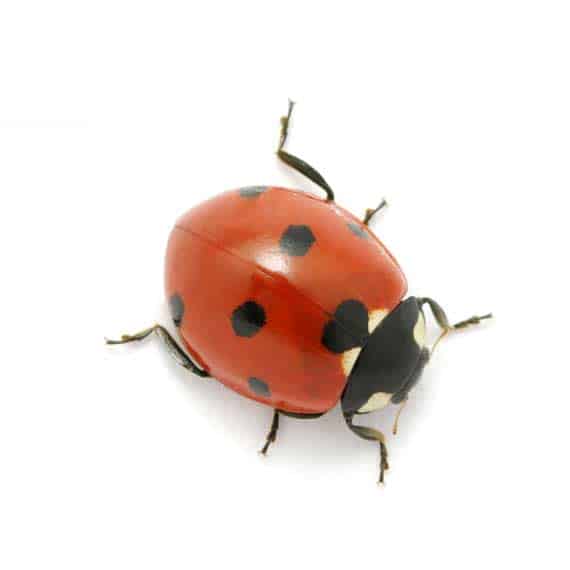
Ladybugs are among our best-known insects, with their familiar dome shape, orange-red bodies, and black spots. The main physical difference between the different types in Canada is the number of black spots on their wing covers (for example, two-spotted and thirteen-spotted lady beetles).
Multicoloured Asian lady beetles, a specific type of ladybug, were brought to North America in the 1970s to control aphids and other crop-eating insects. Their fast reproduction and ability to withstand fairly harsh winters have helped them become one of the main species in Canada. They are slightly larger than native species, usually 6 to 10 mm long (.24 to .39 inches). They range in colour from a mustard yellow to a dark reddish orange. They have a varying number of black spots on their wing covers, and some may not have any spots.
The multicoloured Asian lady beetle also has two white oval markings on either side of its head, and usually has an M-shaped marking just behind its head. As with many other insects, its bold colours are a defence, warning birds and other predators that it will not make a tasty meal.
Ladybugs are among our most beneficial insects. They are voracious and efficient predators of insect pests, and feed on more than 50 species of aphids. A single ladybug will eat thousands of pest insects in its lifetime, helping to protect home gardens as well as valuable commercial orchards and vegetable crops.
Ladybugs do not sting, transmit disease, or infest food supplies. Of the more than 450 species of ladybugs in North America, only three types feed on plants.
But one species (the multicoloured Asian lady beetle) has increasingly become a cause of complaints. That is because they gather in large numbers in the fall (like other species of ladybugs), looking for a safe and dry place to spend the winter. Attracted to homes and buildings with sunny exposures, they will cluster on outside walls and eventually work their way indoors through cracks and openings. Their sheer numbers make them a serious nuisance for some homeowners. Homes near fields or forested areas are more susceptible.
How do I know if I have a problem?
Ladybugs can live up to two or three years if conditions are right. During hibernation, ladybugs feed on their stored fat.
After clustering on outside walls, ladybugs will work their way into dwellings through gaps in doors and window frames, eaves, utility openings, foundations, and wall siding. Once inside, they become confused and gather on the walls, ceilings, and around windows looking for an exit. Most of these stragglers die within a short time, but others may find a safe spot to hibernate in the attic or wall voids, coming out from time to time during mild weather.
A larger invasion can be expected for several days in late winter or early spring when they leave their winter hiding spots and try to move outdoors to mate.
Ladybugs produce several generations each year. The adult females lay clusters of 10 to 50 tiny light yellow eggs near aphid colonies. The larvae (hatched eggs) are spiny and mostly black with orange stripes, and look like tiny alligators. These larvae share the adults’ insatiable appetite for aphids.
How can I get rid of ladybugs?
Preventing ladybugs from entering buildings is the only way to control them. Caulking and weather stripping can keep them outdoors where they belong. Focus on the sunny, southwest sides of your home, as shady areas are much less affected. Fix screens and caulk around windows and door jams. Seal any cracks and crevices in the siding and foundation. Plug holes in roofing, vents, and attic walls. Inspect and seal gaps in service utility entrances.
Once ladybugs have moved in, there are few treatment options. Sweep or vacuum them up, then seal and throw out the bag so they can’t escape back into your home.
No pesticides are currently registered for the control of ladybugs. For pest control in Winnipeg choose GL pest control.


